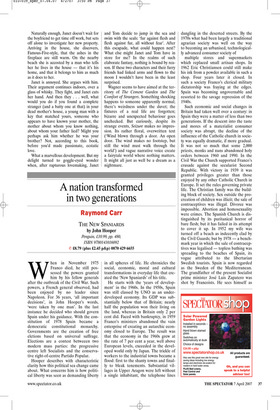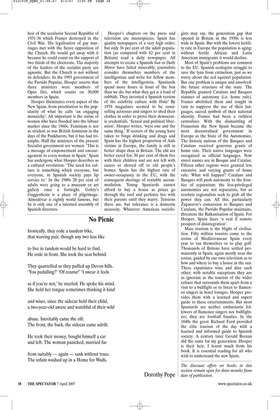A nation transformed in two generations
Raymond Carr
THE NEW SPANIARDS by John Hooper Penguin, ┬Ż10.99, pp. 480, ISBN 9780141016092 Ō£å ┬Ż8.79 (plus ┬Ż2.45 p&p) 0870 429 6655 When in November 1975 Franco died, he still possessed the powers granted him by his fellow generals after the outbreak of the Civil War. Such powers, a French general observed, had been enjoyed by no leader since Napoleon. For 36 years, ŌĆśall important decisionsŌĆÖ, in John HooperŌĆÖs words, ŌĆśwere taken by one manŌĆÖ. In the last instance he decided who should govern Spain under his guidance. With the constitution of 1978 Spain became a democratic constitutional monarchy. Governments are the creation of free elctions based on universal suffrage. Elections are a contest betweeen two modern mass parties: the progressive centre left Socialists and the conservative right-of-centre Partido Popular.
Hooper describes with characteristic clarity how this political sea change came about. What concerns him is how political liberty was seen as demanding liberty in all spheres of life. He chronicles the social, economic, moral and cultural transformations in everyday life that created the ŌĆśNew SpaniardsŌĆÖ of his title.
He starts with the ŌĆśyears of developmentŌĆÖ in the 1960s. In the 1950s, Spain was still classed by UNO as an underdeveloped economy. Its GDP was substantially below that of Britain; nearly half the population won their living on the land, whereas in Britain only 2 per cent did. Faced with bankruptcy, in 1959 FrancoŌĆÖs ministers abandoned the vain enterprise of creating an autarchic economy closed to Europe. The result was that the economy in the 1960s grew at the rate of 7 per cent a year, well above European levels, exceeded in the developed world only by Japan. The trickle of workers to the industrial towns became a flood: first to the shanty towns and finally to bleak tenements. Substantial villages in Upper Aragon were left without a single inhabitant, the telephone lines dangling in the deserted streets. By the 1970s what had been largely a traditional agrarian society was well on the way to becoming an urbanised, technologically advanced consumer society of multiple stores and supermarkets which replaced small artisan shops. In 1962 Eric Christiansen could still make his ink from a powder available in such a shop. Four years later it closed. In such a society FrancoŌĆÖs clerical military dictatorship was fraying at the edges. Spain was becoming ungovernable and resorted to the savage repression of the 1940s.
Such economic and social changes in Britain had taken well over a century: in Spain they were a matter of less than two generations. If the descent into the taste and mores of a materialist consumer society was abrupt, the decline of the influence of the Catholic church in society was equally dramatic, if more gradual. It was not so much that some 2,000 priests, monks and nuns abandoned holy orders between 1960 and 1990. In the Civil War the Church supported FrancoŌĆÖs crusade against the secularist Second Republic. With victory in 1939 it was granted privileges greater than those enjoyed by any other Catholic Church in Europe. It set the rules governing private life. The Christian family was the building block of society. Sex outside the procreation of children was illicit; the sale of contraceptives was illegal. Divorce was impossible. Abortion and homosexuality were crimes. The Spanish Church is distinguished by its puritanical horror of bare flesh; but it has failed in its attempt to cover it up. In 1952 my wife was turned off a beach as indecently clad by the Civil Guards; but by 1978 ŌĆö a benchmark year in which the sale of contraceptives was legalised ŌĆö topless bathing was spreading to the beaches of Spain, its vogue attributed to the libertarian Swedish tourists. Spain is now regarded as the Sweden of the Mediterranean. The grandfather of the present Socialist prime minister Jos├® Luis Zapatero was shot by Francoists. He sees himself as heir of the secularist Second Republic of 1931-36 which Franco destroyed in the Civil War. His legalisation of gay marriages met with the fierce opposition of the Church. He would get away with it because he could count on the support of two thirds of the electorate. The majority of the leaders of the socialist party are agnostic. But the Church is not without its defenders. In the 1993 government of the Partido Popular, Hooper asserts that three ministers were members of Opus Dei, which counts on 30,000 members in Spain.
Hooper illuminates every aspect of the New Spain, from prostitution to the popularity of what he calls ŌĆśan engaging monarchyŌĆÖ. All important is the status of women who have flooded into the labour market since the 1960s. Feminism is not as strident as was British feminism in the days of the Pankhursts, but it has had triumphs. Half the ministers of the present Socialist government are women. ŌĆśThis is a message of empowerment and encouragement to every woman in Spain.ŌĆÖ Spain has undergone what Hooper describes as a cultural revolution. ŌĆśThe need for culture is something which everyone, but everyone, in Spanish society pays lip service to.ŌĆÖ In the 1980s 20 per cent of adults were going to a museum or art gallery once a fortnight. GehryŌĆÖs Guggenheim is a place of pilgrimage. Almod├│var is rightly world famous, but he is only one of a talented assembly of Spanish directors. HooperŌĆÖs chapters on the press and television are masterpieces. Spain has quality newspapers of a very high order; but only 36 per cent of the adult population (as compared with 62 per cent in Britain) read a daily newspaper. All attempts to create a Spanish Sun or Daily Mirror have failed miserably; journalists consider themselves members of the intelligentsia and write for fellow members of the intelligentsia. Spaniards spend more hours in front of the box than we do; but what they get is a load of rubbish. They invented a Spanish version of the celebrity culture with Hola! By 1978 magazines seemed to be counselling actresses and singers to shed their clothes in order to prove their democratic credentials. ŌĆśSexual and political liberationŌĆÖ, Hooper writes, ŌĆśwere one and the same thing.ŌĆÖ If sectors of the young have taken to binge drinking and drugs and Spain has the highest proportion of Aids victims in Europe, the family is still in better shape than in Britain. The old are better cared for; 30 per cent of them live with their children and are not left with carers or shoved off to old peopleŌĆÖs homes. Spain has the highest rate of owner-occupancy in the EU, with the consequent shortage of rentable accommodation. Young Spaniards cannot afford to buy a house as prices go through the roof and perforce live with their parents until they marry. Tensions there are, but tolerance is a domestic necessity. Whatever American sociolo gists may say, the generation gap that opened in Britain in the 1950s is less wide in Spain. But with the lowest fertility rate in Europe the population is aging; without fertile African and Latin American immigrants it would decline.
Most of SpainŌĆÖs problems are common to the EU. Spanish ecologists struggle to save the lynx from extinction, just as we worry about the red squirrel population. But one problem is unique and unsolved: the future structure of the state. The Republic granted Catalans and Basques statutes of autonomy (i.e. home rule). Franco abolished them and sought in vain to suppress the use of their languages, sacred symbols of their national identity. Franco had been a ruthless centraliser. With the dismantling of Francoism the New Spain became the most decentralised government in Europe as the State of the Autonomies. The historic nations of the Basques and Catalans received generous grants of home rule. Their native languages were recognised as official languages. Now street names are in Basque and Catalan. Fifteen other regions were granted less extensive and varying grants of home rule. What will happen? Catalans and Basques will push autonomy to the frontier of separatism; the less-privileged autonomies are not separatists, but as resolute regionalists seek to grab all the power they can. All this, particularly ZapaterosŌĆÖs concession to Basques and Catalans, the Partido Popular maintains, threatens the Balkanisation of Spain. For Hooper, Spain faces ŌĆśa real if remote prospect of disintegrationŌĆÖ.
Mass tourism is the blight of civilisation. Fifty million tourists come to the costas of Mediterranean Spain every year to tan themselves or to play golf. Thousands of Britons have settled permanently in Spain, again mostly near the costas, guided by our own television as to how and where to buy a house in the sun. These expatriates wine and dine each other; with notable exceptions they are as ignorant as the tourists of the wider culture that surrounds them apart from a visit to a bullfight or to listen to flamenco singers in hotel lounges. Hooper provides them with a learned and expert guide to these entertainments. But most Spaniards are neither enthusiastic followers of flamenco singers nor bullfighters; they are football fanatics. In the 1840s the great Richard Ford provided the elite tourism of the day with a learned and informed guide to Spanish society. A century later Gerald Brenan did the same for my generation. Hooper is their heir. I learnt much from his book. It is essential reading for all who wish to understand the new Spain.
The discount offers on books in this section remain open for three months from date of publication.



































































 Previous page
Previous page